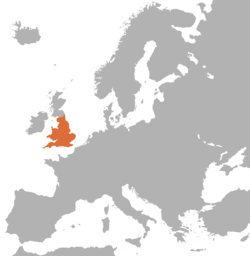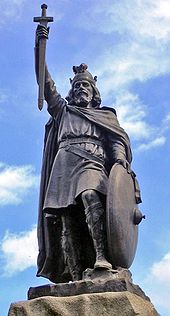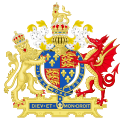- Kingdom of England
-
This article is about the historical state (927–1707). For the modern constituent country of the United Kingdom, see England.
Kingdom of England Personal union with the Kingdom of Scotland
(1603–1649 / 1660–1707)↓ 927–1649
1649–1660 : Commonwealth
1660–1707 →
→

Flag Royal Coat of arms Motto
Dieu et mon droit
(French)
"God and my right"Territory of the Kingdom of England Capital Winchester (before 1066)
London (after 1066)Language(s) Old English (de facto, until 1066)
Norman-French (de jure, 1066 – 15th century)
Middle English (de facto, 1066 – late 15th century)
English (de facto, from 16th century)
Welsh (de facto)
Cornish (de facto)Religion Roman Catholic until 1533 and from 1553 to 1558, Protestant from 1533 to 1553 and from 1558 onward Government Absolute monarchy (before 1215)
Semi-constitutional monarchy (1215–1646, 1660–1689)
Constitutional monarchy (1689–1707)Monarch - 829–839 Egbert of Wessex (first) - 1702–1707 Anne (last) Legislature Witan (before 1066)
Curia Regis (1066–1215)
Parliament (after 1215)History - Egbert of Wessex
becomes Bretwalda829 - Unification by
Athelstan the Glorious12 July 927 - Norman conquest 1066–1088 - Laws in Wales Acts
1535–15421536 and 1543 - Union of the Crowns 1603 - English Interregnum 1649–1660 - Union with Scotland 1 May 1707 Currency Pound sterling Preceded by Succeeded by 
Kingdom of Wessex 
Kingdom of Mercia Kingdom of East Anglia 
Kingdom of Northumbria 
Principality of Wales 
Kingdom of Cornwall Kingdom of Great Britain 
Today part of  United Kingdom
United Kingdom
( England and
England and  Wales)
Wales)History of England 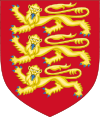
This article is part of a seriesPrehistoric Britain Roman Britain Sub-Roman Britain Anglo-Saxon England Heptarchy Kingdom of England Anglo-Norman England House of Plantagenet House of Lancaster House of York House of Tudor English colonial empire House of Stuart Commonwealth of England The Protectorate Stuart Restoration Glorious Revolution Kingdom of Great Britain United Kingdom of Great Britain
and IrelandUnited Kingdom of Great Britain
and Northern Ireland
England Portal
The Kingdom of England was, from 927 to 1707, a sovereign state to the northwest of continental Europe. At its height, the Kingdom of England spanned the southern two-thirds of the island of Great Britain (including both modern-day England and Wales) and several smaller outlying islands; what today comprises the legal jurisdiction of England and Wales. It had a land border with the Kingdom of Scotland to the north. At the start of the period its capital and chief royal residence was Winchester, but Westminster and Gloucester were accorded almost equal status, with Westminster gradually gaining preference.
England as a state began on 12 July 927 AD after a gathering of kings from throughout Britain at Eamont Bridge, Cumbria, but broadly traces its origins to the Anglo-Saxon settlement of Britain and the Heptarchy of petty states that followed and ultimately united. The Norman invasion of Wales from 1067–1283 (formalised with the Statute of Rhuddlan in 1284) put Wales in England's control, and Wales came under English law with the Laws in Wales Acts 1535–1542. On 1 May 1707, England was united with the neighbouring Scotland to create the Kingdom of Great Britain[1][2] under the terms of the Acts of Union 1707. Though no longer a sovereign state, modern England continues as one of the countries of the United Kingdom.
The City of Westminster in London had become the de facto capital by the beginning of the 12th century. London has thus served as the capital of the Kingdom of England, then the Kingdom of Great Britain (1707–1801) and subsequently as the capital of the United Kingdom of Great Britain & Northern Ireland.
Contents
History
The Kingdom of England has no specific founding date. The Kingdom originated in the kingdoms of the ancestral English, the Anglo-Saxons, which were carved out of the former Roman province of Britannia. The minor kingdoms in time coalesced into the seven famous kingdoms known as the Heptarchy: East Anglia, Mercia, Northumbria, Kent, Essex, Sussex and Wessex. The Viking invasions shattered the pattern of the English kingdoms. The English lands were finally unified in the 10th century in a reconquest completed by King Athelstan in AD 927.
The Anglo-Saxons knew themselves as the Angelcynn, Englisc or Engle. These names were originally names from the Engla, or Angles, but came to be used by Saxons, Jutes and Frisii alike. They called their lands Engla land, meaing "Land of the Angles" (and when unified also Engla rice; "the Kingdom of the English"). In time Englaland became England.
During the Heptarchy, the most powerful King among the Anglo-Saxon kingdoms might become acknowledged as Bretwalda, a high king over the other kings. The decline of Mercia allowed Wessex to become more powerful. It absorbed the kingdoms of Kent and Sussex in 825 AD. The Kings of Wessex became increasingly dominant over the other kingdoms of England during the 9th century.
In 827 AD, Northumbria submitted to Egbert of Wessex at Dore. It has been claimed that Egbert thereby became the first king to reign over a united England, however briefly.
In 886, King Alfred retook London, which he apparently regarded as a turning point in his reign. The Anglo-Saxon Chronicle says that "all of the English people (all Angelcyn) not subject to the Danes submitted themselves to King Alfred."[3] Asser added that "Alfred, king of the Anglo-Saxons, restored the city of London splendidly ... and made it habitable once more."[4] Alfred's "restoration" entailed reoccupying and refurbishing the nearly deserted Roman walled city, building quays along the Thames, and laying a new city street plan.[5] It is probably at this point that Alfred assumed the new royal style 'King of the Anglo-Saxons.'
During the following years Northumbria repeatedly changed hands between the English kings and the Norwegian invaders, but was definitively brought under English control by King Edred in 954 AD, completing the unification of England. At about this time, Lothian, the northern part of Northumbria, was ceded to the Kingdom of Scotland.
England has remained in political unity ever since. During the reign of Ethelred II (who reigned 978–1016)—known to posterity as Ethelred the Unready—a new wave of Danish invasions was orchestrated by Sweyn I of Denmark, culminating after a quarter of a century of warfare in the Danish conquest of England in 1013 AD. But Sweyn died on 2 February 1014 and Ethelred was restored to the throne. In 1015, Sweyn's son King Canute launched a new invasion. The ensuing war ended with an agreement in 1016 between Canute and Ethelred's successor, Edmund Ironside, to divide England between them, but Edmund's death on 30 November of that year left England united under Danish rule. This continued for 26 years until the death of Harthacanute in June 1042. He was the son of Canute and Emma of Normandy (the widow of Ethelred the Unready), and had no heirs of his own; he was succeeded by his half-brother, Ethelred's son, Edward the Confessor. The Kingdom of England was once again independent.
Norman conquest
The peace lasted only until the death of the childless Edward in January 1066. King Edward's brother-in-law was crowned King Harold; but Edward's cousin William the Bastard, later William the Conqueror, Duke of Normandy, immediately claimed the throne for himself. William launched an invasion of England and landed in Sussex on 28 September 1066. Harold and his army were in York following their victory against the Norwegians at the Battle of Stamford Bridge (25 September 1066) when the news reached him. He decided to set out without delay and confront the Norman army in Sussex so marched southwards at once, despite the army not being properly rested following the battle with the Norwegians. The armies of Harold and William faced each other at the Battle of Hastings (14 October 1066), in which the English army, or Fyrd, was defeated, King Harold and his two brothers were slain, and William emerged as victor. William was then able to conquer England with little further opposition. He was not, however, planning to absorb the Kingdom into the Duchy of Normandy. As a mere Duke, William owed allegiance to Philip I of France, whereas in the independent Kingdom of England he could rule without interference. He was crowned King of England on 25 December 1066.
In 1092, King William II, son of William the Conqueror, led an invasion of Strathclyde, a Celtic kingdom in what is now southwest Scotland and Cumbria. In doing so, he annexed what is now the county of Cumbria to England; this was the last major expansion by England into what is now considered a part of England. Later, the Laws in Wales Acts 1535–1542 annexed Wales to England.
In 1124, Henry I ceded what is now southeast Scotland (called Lothian) to the Kingdom of Scotland, in return for the King of Scotland's loyalty. This area of land had been English since its foundation in 927 AD, and before that had been a part of the Anglian Kingdom of Northumbria. Lothian contained what later became the Scottish capital, Edinburgh. This arrangement was later finalised in 1237 by the Treaty of York.
The Kingdom of England and the Duchy of Normandy remained in personal union until 1204. King John, a fourth-generation descendant of William, lost the continental possessions of the Duchy to Philip II of France during that year. A few remnants of Normandy, including the Channel Islands, remained in the possession of King John, together with most of the Duchy of Aquitaine.
Norman conquest of Wales
Up to the time of the Norman conquest of Anglo-Saxon England, Wales had remained for the most part independent of the Anglo-Saxon kingdoms, although some Welsh kings did sometimes acknowledge the Bretwalda, for example.
However, soon after the Norman conquest of England, some of the Norman lords began to attack Wales. They conquered parts of it, which they ruled, acknowledging the overlordship of the Norman kings of England, but with considerable local independence. Over many years these "Marcher Lords" conquered more and more of Wales, against considerable resistance led by various Welsh princes, who also often acknowledged the overlordship of the Norman kings of England.
King John's grandson Edward I of England defeated Llywelyn the Last, and so effectively conquered Wales, in 1282. He created the title Prince of Wales for his eldest son Edward II in 1301. Edward's conquest was brutal and the subsequent repression considerable, as the magnificent Welsh castles such as Conwy, Harlech and Caernarfon attest; but this event re-united under a single ruler the lands of Roman Britain for the first time since the establishment of the kingdom of the Jutes in Kent in the 5th century AD, some 700 years before.
Accordingly, this was a highly significant moment in the history of medieval England, as it re-established links with the pre-Saxon past. These links were exploited for political purposes to unite the peoples of the kingdom, including the Anglo-Normans, by popularising Welsh legends.
The Welsh language—derived from the British language, with significant Latin influences—continued to be spoken by the majority of the population of Wales for at least another 500 years, and is still today a majority language in parts of the country.
Loss of the Angevin Empire and the Wars of the Roses
Edward III of England, son of Edward II, was the first English king to have a claim to the throne of France. Edward III pursued this claim, which resulted in the Hundred Years' War (1337–1453). The war pitted five Kings of England of the House of Plantagenet against five Kings of France of the Capetian House of Valois. Though the English had numerous celebrated victories, they were unable to overcome the numerical superiority of the French. England was defeated, retaining only a single town in France, Calais.
During the Hundred Years War an English identity began to develop in place of the previous division between the Norman Lords and their Anglo-Saxon subjects, in consequence of sustained hostility to the increasingly nationalist French, whose kings and other leaders (notably the charismatic Joan of Arc) used a developing sense of French identity to help draw people to their cause. The Anglo-Normans became separate from their cousins, who held lands mainly in France, who mocked the former for their archaic and bastardised spoken French. English also became the language of the law courts during this period.
The Kingdom had little time to recover before entering the Wars of the Roses (1455–1487), a series of civil wars over possession of the throne between the House of Lancaster (whose heraldic symbol was the red rose) and the House of York (whose symbol was the white rose), each led by different branches of the descendants of Edward III. The end of these wars found the throne held by the descendant of an initially illegitimate member of the House of Lancaster, married to the eldest daughter of the House of York: Henry VII of England and his Queen consort, Elizabeth of York. They were the founders of the Tudor dynasty, which ruled the Kingdom from 1485 to 1603.
Tudors and Stuarts
Wales had retained a separate legal and administrative system, which had been established by Edward I in the late 13th century. Under the Tudor monarchy, which was of Welsh origin, Henry VIII of England—a son of Henry VII—replaced the laws of Wales with those of England (under the Laws in Wales Acts 1535–1542). Wales now ceased to be a personal fiefdom divided between the Prince of Wales and Earl of March, and was instead annexed to the Kingdom of England, and henceforth was represented in the Parliament of England.
During the 1530s, Henry VIII overthrew the power of the Roman Catholic Church within the kingdom, replacing the Pope as head of the English church, and seizing the church's lands, thereby beginning the creation of a new Protestant religion. This had the effect of aligning England with Scotland, which also gradually adopted a Protestant religion, whereas the most important continental powers, France and Spain, remained Roman Catholic.
In 1541, during Henry VIII's reign, the Parliament of Ireland proclaimed him King of Ireland, thereby bringing the Kingdom of Ireland into personal union with the Kingdom of England.
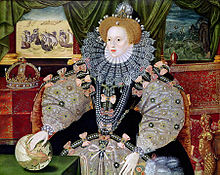 Portrait of Elizabeth made to commemorate the defeat of the Spanish Armada (1588), depicted in the background. Elizabeth's international power is symbolised by the hand resting on the globe.
Portrait of Elizabeth made to commemorate the defeat of the Spanish Armada (1588), depicted in the background. Elizabeth's international power is symbolised by the hand resting on the globe.
During the reign of Mary I of England, eldest daughter of Henry VIII, Calais—the last remaining continental possession of the kingdom—was lost: captured by the French, under Francis, Duke of Guise, on 7 January 1558.
Henry VIII's younger daughter, Elizabeth I of England, consolidated the new Protestant Church of England. She also began to build up the kingdom's naval strength, on the foundations her father had laid down. In 1588 her new navy was strong enough to defeat the Spanish Armada, which had sought to invade England in order to put a Catholic monarch on the throne in her place.
The House of Tudor ended with the death of Elizabeth I on 24 March 1603. James VI, King of Scots (a descendant of Margaret Tudor, Henry VIII's sister), from Scotland's House of Stuart, ascended the throne of England, becoming King James I of England. He was a Protestant. Despite the Union of the Crowns, the Kingdom of England and the Kingdom of Scotland remained separate and independent states under this personal union: a state of affairs which lasted for more than a century.
The Stuart kings, however, over-estimated the power of the English monarchy, and were cast down by Parliament in 1645 and 1688. In the first instance, Charles I's introduction of new forms of taxation, in defiance of Parliament, led to the English Civil War (1641–45), in which the king was defeated, and to the consequent abolition of the monarchy under Oliver Cromwell, during the interregnum of 1649–1660. Henceforth, the monarch could reign only at the will of Parliament.
Following the Restoration of the monarchy in 1660, an attempt by James II (a son of Charles I) to reintroduce Roman Catholicism—a century after its suppression by the Tudors—led to the Glorious Revolution of 1688, in which he was deposed by Parliament. The Crown was then offered by Parliament to James II's daughter and son-in-law/nephew, Protestant princes of Orange, William III and Mary II.
In 1707, Acts of Union were passed by both the Parliament of Scotland and the Parliament of England, to ratify the 1706 Treaty of Union, and bring into being the new Kingdom of Great Britain. Queen Anne, the last monarch of the House of Stuart, became the first monarch of the new kingdom. The English and Scottish Parliaments were merged into the Parliament of Great Britain, located in Westminster, London. At this point England ceased to exist as a separate political entity, and since then has had no national government. The laws of England were unaffected, with the legal jurisdiction continuing to be that of England and Wales, while Scotland continued to have its own laws and law courts. This continued after the Act of Union of 1800 between the Kingdom of Great Britain and the Kingdom of Ireland, which created the United Kingdom of Great Britain and Ireland (which would later become the United Kingdom of Great Britain and Northern Ireland).
Commonwealth and Protectorate
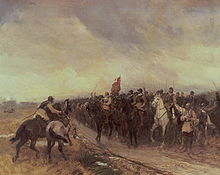 Cromwell at Dunbar. Oliver Cromwell united the whole of the British Isles by force and created the Commonwealth of England.
Cromwell at Dunbar. Oliver Cromwell united the whole of the British Isles by force and created the Commonwealth of England.
England was a monarchy for the entirety of its political existence, from its creation around 927 AD up until the 1707 Acts of Union, except for the eleven years of the English Interregnum (1649 to 1660) which followed the English Civil War.
The rule of the executed King Charles I was replaced by that of a republic known as the Commonwealth of England (1649–1653). The most prominent General of the republic's New Model Army, Oliver Cromwell, managed to extend its rule to Ireland and Scotland.
The victorious Cromwell eventually turned against the republic, and established a new form of government known as The Protectorate, with himself as Lord Protector until his death on 3 September 1658. He was succeeded by his son Richard Cromwell. However, anarchy eventually developed, as Richard proved unable to maintain his rule. He resigned his title and retired into obscurity.
The Commonwealth was then re-established, but proved to be unstable, so the exiled claimant, Charles II, was recalled to the throne by Parliament in 1660 in the English Restoration.
Union with Scotland
In the Scottish case, the attractions were partly financial and partly to do with removing English trade sanctions put in place through the Alien Act 1705. The English were more anxious about the Royal succession. The death of King William III in 1702 had led to the succession of Queen Anne to the crowns of England and Scotland, but her only surviving child had died in 1700, and the English Act of Settlement 1701 had given the Succession to the English crown to the Protestant House of Hanover. Securing the same succession in Scotland became the primary object of English strategic thinking towards Scotland. By 1704, the Union of the Crowns was in crisis, with the Scottish Act of Security allowing for the Scottish Parliament to choose a different monarch, which could in turn lead to an independent foreign policy during a major European war. The English establishment did not wish to risk a Stuart on the Scottish throne, nor the possibility of a Scottish military alliance with another power.
A Treaty of Union was agreed on 22 July 1706, and following the Acts of Union of 1707, which created the Kingdom of Great Britain, the independence of the Kingdoms of England and Scotland came to an end on 1 May 1707. The Acts of Union also created a customs union and monetary union and provided that any "laws and statutes" that were "contrary to or inconsistent with the terms" of the Acts would "cease and become void."
Anne was succeeded by her second cousin George I of the House of Hanover, who was a descendant of the Stuarts through his maternal grandmother, Elizabeth, daughter of James I and VI.
See also
- List of monarchs of England
- English colonial empire
- Royal Navy
- Crown Jewels of England
- England and Wales
- Kingdom of Cornwall (Kernow)
- Etymology of England
- Anglo-Norman language
References
- ^ Acts of Union 1707 parliament.uk, accessed 27 January 2011
- ^ Making the Act of Union 1707 scottish.parliament.uk, accessed 27 January 2011
- ^ The Anglo-Saxon Chronicle Freely licensed version at Gutenberg Project. Note: This electronic edition is a collation of material from nine diverse extant versions of the Chronicle. It contains primarily the translation of Rev. James Ingram, as published in the Everyman edition.
- ^ Asser's Life of King Alfred, ch. 83, trans. Simon Keynes and Michael Lapidge, Alfred the Great: Asser's Life of King Alfred & Other Contemporary Sources (Penguin Classics) (1984), pp. 97–8.
- ^ Vince, Alan, Saxon London: An Archaeological Investigation, The Archaeology of London series (1990).
Bibliography
- Wood, Michael, In Search of the Dark Ages (London: BBC Books, 1981)
- Elton, G. R., England under the Tudors (London: Methuen, 1955)
- Elton, G. R., The Tudor Revolution in Government: Administrative Changes in the Reign of Henry VIII (Cambridge University Press, 1953)
- Elton, G. R., The Reformation (Cambridge University Press, 1958)
- Elton, G. R., The Tudor Constitution: Documents and Commentary (Cambridge University Press, 1960)
- Elton, G. R., ed., England, 1200–1640: sources of history. ([-?-]: Cornell Press )
- Elton, G. R. Studies in Tudor and Stuart Politics and Government: Papers and Reviews. 4 volumes (Cambridge University Press, 1974–1992) (1946–1972—1983–1990)
Preceded by
The Heptarchy
c.500 – c.927Kingdom of England
c.927 – 1649Succeeded by
English Interregnum
1649 – 1660Preceded by
English Interregnum
1649 – 1660Kingdom of England
1660 – 1707Succeeded by
Kingdom of Great Britain
1707 – 1800British Isles Politics Political cooperationBritish–Irish Council · British–Irish Parliamentary Assembly · Common Travel Area · North/South Ministerial Council · British-Irish Intergovernmental ConferenceGeography Island groupsChannel Islands · Islands of the Clyde · Great Britain · Hebrides (Inner · Outer) · Ireland · Isle of Man · Isles of Scilly · Northern Isles (Orkney · Shetland)Lists of islands ofHistory Current states and
dependenciesIreland · United Kingdom (England · Northern Ireland · Scotland · Wales)
Guernsey · Jersey · Isle of ManFormer statesIrish Free State · Kingdom of England (Principality of Wales) · Kingdom of Great Britain · Kingdom of Ireland · Kingdom of ScotlandSociety Modern languagesPeopleCategories:- Former countries in the British Isles
- States and territories established in 927
- States and territories disestablished in 1707
- History of England
- Former monarchies of Europe
- 1707 disestablishments
- Former kingdoms
- Kingdom of England
Wikimedia Foundation. 2010.

